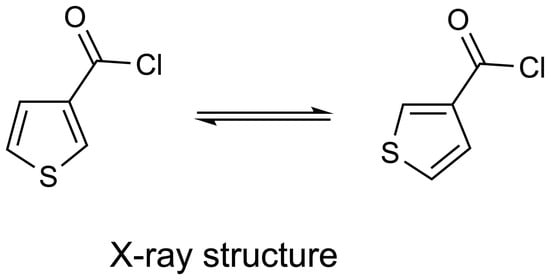Thiophene-3-carbonyl Chloride
Abstract
:1. Introduction
2. Results
3. Experimental
Supplementary Materials
Author Contributions
Funding
Data Availability Statement
Conflicts of Interest
References
- Steinkopf, W.; Schmitt, H.F. Studien in der Thiophenreihe, XLI. Einige Abkömmlinge des 3-Jodthiophens. Justus Liebigs Ann. Chem. 1938, 533, 264–269. [Google Scholar] [CrossRef]
- Aitken, R.A.; Bibby, M.C.; Bielefeldt, F.; Double, J.A.; Laws, A.L.; Mathieu, A.-L.; Ritchie, R.B.; Wilson, D.W.J. Synthesis and antitumour activity of new derivatives of flavone-8-acetic acid (FAA). Part 3: 2-heteroaryl derivatives. Arch. Pharm. Pharm. Med. Chem. 1998, 331, 405–411. [Google Scholar] [CrossRef]
- Martin, L.J.; Marzinzik, A.L.; Ley, S.V.; Baxendale, I.R. Safe and reliable synthesis of diazoketones and quinoxalines in a continuous flow reactor. Org. Lett. 2011, 13, 320–323. [Google Scholar] [CrossRef] [PubMed]
- Hudson, P.; Robertson, J.H. The crystal and molecular structure of β-thiophenic acid. Acta Crystallogr. 1964, 17, 1497–1505. [Google Scholar] [CrossRef]
- Roux, M.V.; Temprado, M.; Jiménez, P.; Dávalos, J.Z.; Foces-Foces, C.; García, M.V.; Redondo, M.I. Thermophysical, crystalline and infrared studies of the 2- and 3-thiophenecarboxylic acids. Thermochim. Acta 2003, 404, 235–244. [Google Scholar] [CrossRef]
- Shtukenberg, A.G.; Zhu, X.; Yang, Y.; Kahr, B. Common occurrence of twisted molecular crystal morphologies from the melt. Cryst. Growth Des. 2020, 20, 6186–6197. [Google Scholar] [CrossRef]
- Howell, S.J.; Day, C.S.; Noftle, R.E. Synthesis and characterization of 3-thiophene carboxamides containing a pyridine ring: Structure, electrochemistry, and complexation. Inorg. Chim. Acta 2005, 358, 3711–3723. [Google Scholar] [CrossRef]
- Dai, J.; Day, C.S.; Noftle, R.E. Synthesis and structural characterization of 3-thienyl alkyl imides. Tetrahedron 2003, 59, 9389–9397. [Google Scholar] [CrossRef]
- Rodrigues, D.A.; de Sena, M.; Pinheiro, P.; Sagrillo, F.S.; Freitas, M.C.R.; Alves, M.A.; Thota, S.; Tinoco, L.W.; Magalhães, A.; Sant’Anna, C.M.R.; et al. Structure-property relationship studies of 3-acyl-substituited furans; the serendipitous identification and characterization of a new non-classical hydrogen bond donor moiety. New J. Chem. 2020, 44, 10994–11005. [Google Scholar] [CrossRef]
- Rozycka-Sokolowska, E.; Borowski, A.; Marciniak, B. 1-(Thiophen-3-yl)ethanone. Acta Crystallogr. Sect. C 2011, 67, o209–o211. [Google Scholar] [CrossRef] [PubMed]
- Prek, B.; Grošelj, U.; Kasunic, M.; Zupančič, S.; Svete, J.; Stanovnik, B. Reactions of methyl ketones and (hetero)arylcarboxamides with N,N-dimethylacetamide dimethyl acetal. A simple metal-free synthesis of 2,4,6-trisubstituted pyridines. Aust. J. Chem. 2015, 68, 184–195. [Google Scholar] [CrossRef]
- He, Y.; Su, G.; Shi, J. 3-(4-Methylphenyl)-1-(3-thienyl)-2-propen-1-one. Acta Crystallogr. Sect. C 1995, 51, 989–991. [Google Scholar] [CrossRef]
- Davanagere, H.; Arasalike, J.; Quah, C.K.; Kwong, H.C.; Patil, P.S. Investigation of structural, physical, linear, and nonlinear optical properties of two novel thiophene centred D-π-A type push-pull organic derivatives for nonlinear optical applications. J. Mol. Struct. 2020, 1220, 128763. [Google Scholar] [CrossRef]
- Hursthouse, M.B.; Light, M.E.; Murphy, P. Experimental crystal structure determination. CSD Commun. 2003. [Google Scholar] [CrossRef]
- Crundwell, G.; Meskill, T.; Sayers, D.; Kantardjieff, K. 1,3-Di-3-thienyl-2-hydroxyethanone (3,3′-thenoin). Acta Crystallogr. Sect. E 2002, 58, o668–o670. [Google Scholar] [CrossRef]
- Milios, C.J.; Inglis, R.; Vinslava, A.; Bagai, R.; Wernsdorfer, W.; Parsons, S.; Perlepes, S.P.; Christou, G.; Brechin, E.K. Toward a magnetostructural correlation for a family of Mn6 SMMs. J. Am. Chem. Soc. 2007, 129, 12505–12511. [Google Scholar] [CrossRef] [PubMed]
- Zhou, C.-L.; Wang, Z.-M.; Wang, B.-W.; Gao, S. Two Mn6 single-molecule magnets with sulfur-contained capping ligand. Polyhedron 2011, 30, 3279–3283. [Google Scholar] [CrossRef]
- Kim, J.; Jo, H.; Yoon, S.W.; Lee, M.H.; Choi, W.-J.; Choi, K.-Y.; Ok, K.M. Synthesis, structure, and characterization of variable chains in a series of transition metal coordination compounds. Eur. J. Inorg. Chem. 2020, 452–460. [Google Scholar] [CrossRef]
- Su, Y.-M.; Ji, B.-Q.; Shao, F.; Zhang, S.-S.; Jagodic, M.; Jaglicic, Z.; Gao, Z.-Y.; Dou, J.-M.; Sun, D. Carboxylic acid-tuned nickel(II) clusters: Synthesis, structures, solution behaviours and magnetic properties. Dalton Trans. 2021, 50, 4355–4362. [Google Scholar] [CrossRef] [PubMed]
- Sheldrick, G.M. A short history of SHELXL. Acta Crystallogr. Sect. A 2008, 64, 112–122. [Google Scholar] [CrossRef] [PubMed] [Green Version]



| Entry | X (Figure 2) | CSD Ref Code | Ring Flip Disorder? | Ref. |
|---|---|---|---|---|
| 1 | Cl | — | Yes | (this work) |
| 2 | OH (103 K) | THIPAC | No | [4] |
| 3 | OH (293 K) | THIPAC01 | No | [5] |
| 4 | NH2 | HUZGOB | Yes | [6] |
| 5 | NHCH2CO2H | HUZGIV | Yes | [6] |
| 6 | NHCH2-2-Pyr | TASTIR | Yes | [7] |
| 7 | NHCOMe | UMIKUW | Yes | [8] |
| 8 | NHCOEt | UMILAD | Yes | [8] |
| 9 | NHCOPrn | UMILEH | No | [8] |
| 10 | NHCOBut | UMILIL | No | [8] |
| 11 | NH-N=CHPh | ZUQZUJ | Yes | [9] |
| 12 | Me | ISAZIM | Yes | [10] |
| 13 | CH=C(Me)NH2 | GUGMEC | Yes | [11] |
| 14 | CH=CHC6H4Me-4 | WAMXOX01 | Yes | [12] |
| 15 | CH2COC6H4-NO2-4 | SUXFEZ | Yes | [13] |
Publisher’s Note: MDPI stays neutral with regard to jurisdictional claims in published maps and institutional affiliations. |
© 2021 by the authors. Licensee MDPI, Basel, Switzerland. This article is an open access article distributed under the terms and conditions of the Creative Commons Attribution (CC BY) license (https://creativecommons.org/licenses/by/4.0/).
Share and Cite
Aitken, R.A.; Slawin, A.M.Z. Thiophene-3-carbonyl Chloride. Molbank 2021, 2021, M1254. https://0-doi-org.brum.beds.ac.uk/10.3390/M1254
Aitken RA, Slawin AMZ. Thiophene-3-carbonyl Chloride. Molbank. 2021; 2021(3):M1254. https://0-doi-org.brum.beds.ac.uk/10.3390/M1254
Chicago/Turabian StyleAitken, R. Alan, and Alexandra M. Z. Slawin. 2021. "Thiophene-3-carbonyl Chloride" Molbank 2021, no. 3: M1254. https://0-doi-org.brum.beds.ac.uk/10.3390/M1254







